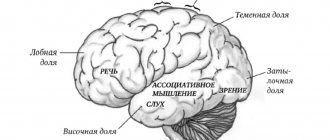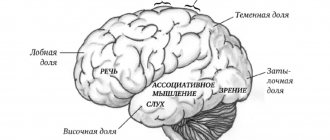Emotions are inherent in all people, they are an important component of our lives, and in our assessments of other people we are largely guided by the feelings they evoke. On the other hand, external manifestations of emotional states create a unique, inimitable image of each person. Emotionality, as a personality quality, is natural and necessary in communication, in professional activities, and in personal life. But excessive demonstration of emotions is tiring and often annoying; it interferes with normal interaction with people and is often a source of conflict. To understand what increased emotionality is associated with, you need to understand the psychology of this personal quality.
Personality emotionality
Each person's emotional system is individual. The individual psychological manifestation of emotions in each person is denoted by the concept of “personal emotionality” - this is the ability to reflect the content of experiences, mood and character. Otherwise, emotionality can be considered as a response to the world around us through the manifestation of feelings and their influence on human behavior. Emotions help to better understand each other, people can tune in to joint activities and communication, and also observe the state of the interlocutor. People belonging to different cultures are able to accurately perceive and evaluate each other’s emotional states such as delight, irritation, sadness, disappointment, pride, admiration, etc.
20.6. Emotional properties of a person
The emotional properties of a person play an important role. According to N.E. Visotska, emotional excitability contributes to successful training as a ballet dancer, positively influencing expressiveness, artistry, danceability, success in classical and conventional dance, as well as acting.
Emotional properties of a person:
- emotional excitability is the degree of readiness for an emotional response to stimuli that are significant to a person. It appears through irritability, hot temper, incontinence, ardor; promotes sensitivity, vulnerability, etc.;
- the depth of experiencing emotions (emotional depth) is expressed in how deeply a person experiences emotions;
- emotional rigidity - lability. Emotional rigidity is the stability of an emotion, which manifests itself in the fact that having arisen in response to a certain event or situation, this emotion continues to manifest itself, despite the fact that the circumstances have already changed and the pathogen has ceased to act. Lability of emotions (mobility, ability to switch) - lies in the fact that a person freely leaves some emotional situations and quickly adapts to others. Sometimes this predetermines her reactivity, impulsiveness, which means that the person has poor self-control;
- emotional stability is considered as: a) the ability not to get emotionally excited in situational conditions, to suppress emotional reactions, to self-control them; b) emotional restlessness, non-reaction to emotional stimuli;
- Expressiveness is the manifestation of a person’s emotions through facial expressions, gestures, voice, motor skills, pantomime, broadcasting, etc. According to the degree of manifestation of expression, they distinguish: a) hypomimia (amimia) - means the absence or weakening of facial expressions, gestures, impoverishment of the expressive means of language, monotony of intonation, dull gaze, etc.; b) hypermia, which is associated with an extreme identification of means of expressing emotions, with a wealth of vivid expressive states that quickly change;
- emotional response is the degree of sensitivity and perception. For V.V. Smartly, it manifests itself in how easily, quickly and flexibly a person reacts emotionally to various influences - social events, the communication process, characteristics of partners, “on business”, “subject”, “nature”, “on oneself”, etc. .;
- emotional optimism - pessimism.
The characteristics of emotional response that are constantly and clearly manifested in a given person are her emotional properties.
From a physiological point of view, emotional excitability is nothing more than emotional readiness, that is, the readiness to react emotionally to stimuli that are significant to a person. Adrenaline plays a significant role in the formation of this readiness. Its introduction to the experimental subjects predetermined that they began to show emotional outbursts in response to those stimuli that had previously left them completely calm.
Emotional excitability contributes to the effectiveness of certain types of professional activities.
Emotional response (receptivity, sensitivity). Close in meaning to emotional excitability is a property that is designated as an emotional response.
Loss of emotional resonance is the complete or almost complete absence of an emotional response to various events.
Vulnerability. K.K. Platonov defines vulnerability as a personality property, which is expressed in the dominance of impressions over the cognitive function of perceiving the world. At the same time, he understands impression as a mental phenomenon, the structure of which includes a fuzzy perception, enhanced by its emotional coloring, through which experiences dominate in him over cognition.
Emotional depth. A.F. Lazursky wrote: “Observing several individuals for a long time, we are convinced that in some of them feelings can, under certain conditions, reach such an intensity that others are completely incapable of. It is precisely this ability to experience, under certain favorable circumstances, such intense feelings that are accessible to relatively only some, that we will call the power of feeling.” This property is equivalent to the intensity, the depth of the emotion that is experienced.
Objective indicators of the intensity of emotions experienced by a person can be changes in physiological functions. However, Lazursky notes that they are not always sufficient, because vegetative excitability varies from person to person.
Emotional rigidity - lability. Emotional rigidity, which A.F. Lazursky called the stability of emotions, the scientist defined it as follows: this is the same period of time for a given person during which the emotion that arose continues to manifest itself, despite the fact that the circumstances have already changed and the stimulus has ceased to act.
Emotionally rigid people are distinguished by the “viscosity” of their emotions and their stability. Emotional stickiness is associated with the fixation of attention and affect on certain significant events, objects, traumatic circumstances, on failures and images (grudges), and on topics that excite. On this occasion, people say: “He talks for three days, but everything is about poverty.”
The instability of emotion, according to Lazursky, is manifested in the fact that at first it can be intense, but then quickly weakens and, in the end, stops, turning into a state of calm indifference. If a person’s emotions are easily excitable, then the past emotion is very quickly replaced by another.
So, the lability of emotions (mobility, switching) is characterized by the fact that a person quickly reacts to changing situations, circumstances and partners, freely leaves some emotional states and enters others.
Too much lability of emotions can complicate relationships with others, because the person becomes reactive, impulsive, and has poor self-control.
Emotional lability is characteristic of individuals with high neuroticism (anxiety). On the contrary, low neuroticism corresponds to emotional rigidity.
Emotional stability. The concept of “emotional stability,” depending on the authors, includes various emotional phenomena. Some authors consider emotional stability as “stability of emotions”, rather than a person’s functional resistance to emotional conditions. At the same time, “stability of emotions” is understood as emotional stability and stability of emotional states, and the absence of a tendency to frequently change emotions. So, one concept combines various phenomena that do not coincide in meaning with the concept of “emotional stability.”
E.O. Milleryan in the book “Psychological Selection of Pilots” wrote that emotional stability should also be understood as immunity to sociogenic factors (along with the ability to control and restrain asthenic emotions that arise). J. Reikovsky believes that in some people emotional stability manifests itself through their low emotional sensitivity. K.K. Platonov and L.M. Schwartz, emotionally unstable include those who are highly emotionally excitable and subject to frequent changes in emotional states. At the same time, the authors recognize the important role of freedom in ensuring the effectiveness of activities when strong emotions arise. M.D. Levitov connects emotional instability with instability of moods and emotions, and L.S. Slavina - with an “affect of inadequacy”, which manifests itself in increased vulnerability, isolation, stubbornness, and negativism.
Foreign authors also understand emotional stability. J. Guilford considers emotional instability as easy excitability, pessimism, concern, and mood swings. P. Fress, as the main characteristic of emotionality, identifies emotional instability (neuroticism), which is characterized by a person’s sensitivity to emotional situations.
So, emotional stability, from the point of view of the above-mentioned authors, is characterized by emotional equanimity, invulnerability, that is, a person’s non-reaction to emotional stimuli and situations.
In other cases, emotional stability is understood as a degree of emotional arousal that does not exceed the maximum value and does not disrupt human behavior (Ya. Reikovsky) and even has a positive effect on the effectiveness of activity.
L.M. Abolin considers it legitimate to understand emotional stability as the stability of the productivity of activities carried out under stressful conditions.
Hence, the main criterion of emotional stability for many scientists is the effectiveness of activity in an emotional situation. A.A. Sirotin includes in the definition of emotional stability a person’s ability to successfully solve complex and responsible tasks in a tense emotional environment.
EMOTIONAL STABILITY - the ability to suppress emotional reactions, that is, “willpower”, which manifests itself in patience, perseverance, self-control, endurance (self-control), which determine the stability of the effectiveness of activities.
It is no coincidence that K.K. Platonov divides emotional stability into emotional-volitional (the degree of volitional control of a person’s emotions), emotional-motor (stability) and psychomotor emotional-sensory (stability of sensory actions).
Another approach to understanding emotional stability is in P.B. Zilberman, who understands this concept as “an integrative property of personality, which is characterized by such an interaction of emotional, volitional, intellectual and motivational components of an individual’s mental activity that ensure optimal successful achievement of the goal of activity in a complex emotional environment.” The same position of B.Kh. Vardanyan, who defines emotional stability as “a personality trait that ensures a harmonious relationship between all components of activity in an emotional situation, and therefore contributes to the successful performance of activity.”
M.I. Dyachenko and V.A. Ponomarenko understand emotional stability as a personality quality and mental state that ensures appropriate behavior in extreme situations.
According to E.P. Ilyina, we should talk about real emotional stability when we determine:
- the time of appearance of an emotional state during long-term and constant action of an emotiogenic factor (for example, the time of appearance of a state of monotony and emotional oversaturation when performing monotonous work); the later emotional states arise, the higher the emotional stability;
- the power of emotsiogenic influence, which causes a certain emotional state (fear, joy, grief, etc.); the greater the strength of this impact (for example, the significance of loss or success), the higher the person’s emotional stability.
Additionally, there is no “general” emotional stability. With different emotsiogenic factors, this stability will be different.
Expressiveness. The manifestation of emotions in people is individual, and therefore they talk about such a personal characteristic as expressiveness. The more a person expresses his emotions through facial expressions, gestures, voice, and motor reactions, the more expressiveness is expressed in him. Expressiveness is an integral function of two applications: the degree of expression (strength) of emotions and control over their manifestation.
According to the degree of expression (in particular, on the face), hypomimia and hypermia are distinguished.
Hypomimia (amymia) means the absence or weakening of facial expressions, gestures, impoverishment of the expressive means of language, monotony of intonation, a look that has gone out and expresses nothing.
Hypermia is associated with excessive animation of the means of expressing emotions, with an abundance of bright and expressive acts that change quickly. It happens in different forms and is caused by many reasons.
Hypermia is often expressed in the unreasonable laughter of teenagers. A lieutenant who turns into a teenager is a common occurrence in teenagers. It can hide shyness.
Another manifestation of hypermia is mannerism of poses and pretentious movements, especially in children with autism.
Emotionality as an integral property of a person. Emotionality as a property (quality) of personality was mentioned by Hippocrates when he spoke about the choleric type of temperament. At the end of the 19th century. P. Malaper identified a special type of emotional people next to apathetic and passionate ones. G. Heymans and E. Wiersma identified three main personality factors: emotionality, activity and reactivity. People often judge emotionality based on how much they take little things to heart, get carried away, or cry over small things.
It is also obvious that those feelings that are most characteristic of a given individual are aroused in him much more easily and can reach much greater intensity than all the others. So, O. Lazursky identified in Russian psychology a phenomenon that much later began to be considered as a human property - emotionality.
Emotionality is also considered by G. Craig as a qualitative characteristic of hyperemotion. For her, emotionality is the tendency to easily give in to fear and anger.
V.D. Nebilitsin also considered emotionality as one of the properties of temperament. He defined the level of a person’s emotionality as the ability for emotional experience (taking into account the modality of this experience). He identifies vulnerability, impulsivity and emotional lability as the main characteristics of emotionality.
Vulnerability expresses a person’s affective susceptibility, its sensitivity to emotional influences, its ability to find the ground for emotional reactions where such ground does not exist for others. Therefore, we are talking about emotional excitability.
impulsivity as the speed with which emotion becomes the motivating force of actions and actions without prior thinking and a conscious decision to carry them out (E.P. Ilyin does not agree with the understanding of impulsivity as a reflexive reaction to an emotional change that has arisen).
By emotional lability he understands the speed with which the present emotional state ceases and one experience is replaced by another.
The substantive aspects of emotionality reflect phenomena in a situation that are of particular significance for a person. The qualitative properties of emotionality characterize the individual’s attitude towards the phenomena of the surrounding world and are expressed in the sign and modality of the dominant emotions. On the dynamic properties of emotionality A.E. Olshannikova lists the peculiarities of the emergence, course and cessation of emotional processes and their external expression (expression). Following V.D. Nebilitsinim, she considers emotionality one of the main components of temperament.
Consideration of emotionality as a property of temperament makes us talk about its genetic origin.
In addition, two trends were found in emotional-cognitive connections. The first is messages of “analyticity” with negative emotionality of a passive-defensive kind. This means that the higher a person’s assessment of fear and amount (distress), the more prone she is to operations of dissociation, differentiation, and emphasizing specific features of objects. The second trend is messages of “syntheticity” with negative emotionality of an active-external kind. In other words, the higher the anger rating, the more a person is focused on the operations of unification, establishing commonality, similarity.
Emotionality and sociability. A.P. Savinkova, studying the connection between emotionality and sociability, showed that a wide circle of communication, its high activity in combination with short-term duration are characteristic of individuals with positive emotional attitudes (dominance of the emotion of joy), and a narrow circle of communication, low communication activity against the backdrop of stable relationships - for individuals with a tendency to experience negative emotions (fear, sadness). The first ones are more proactive in communication. A connection was discovered between the emotion of joy and such dynamic aspects of communication as the need for it, initiative, ease, and expressiveness of communication. Negative connections were also found between asthenic emotions and communication activity, in particular between “anger” and “fear”, ease and breadth of social circle.
M.B. Depenchuk found that people (in particular men) with high emotionality adapt less well to the sociocultural environment of the country to which they emigrated. They master the language of the country of residence to a lesser extent and are less familiar with local life.
1. Vari M.Y. General psychology: Textbook. allowance for students. psychol. and teacher. specialties. - Lvov: Krai, 2005.
2. Vasilyuk F.E. Psychology of experience. - M.: Moscow State University Publishing House, 1984.
3. Vilyunas V.K. Psychology of emotional phenomena. - M.: Publishing house Moscow. University, 1976.
4. James V. Psychology / Transl. from English - M., 1991.
5. Dodonov B.I. In the world of emotions. - K.: Politizdat, 1987.
6. Dodonov B.I. Classification of emotions in the study of the emotional orientation of a person // Questions of psychology. - 1975. - No. 6.
7. Dodonov B.I. Emotion as a value. - M., 1978.
8. Zarudnaya A.A. Emotions and feelings // Psychology: Textbook. - Minsk, 1970.
9. Izard K. Psychology of emotions. - St. Petersburg: Peter, 2000.
10. Izard K. Human emotions. - M., 1980.
11. Ilyin E.L. Emotions and feelings. - St. Petersburg: Peter, 2002.
12. Kitaev-Smyk L.A. Psychology of stress. - M.: Nauka, 1983.
13. Kondash O. Excitement: fear of testing. - K., 1981.
14. Kulikov L.V. Psychology of mood. - St. Petersburg, 1997.
15. Lazarus G. Theory of stress and psychophysiological studies // Emotional stress. - L., 1970.
16. Lindsley D.B. Emotions // Experimental psychology / Ed. S.S. Stevens - M., 1960. -S. 629-684.
17. Nikiforov A.S. Emotions in our life. - M.: Sov. Russia, 1974.
18. Rean A.A. Aggression and aggressive personality. - St. Petersburg, 1996.
19. Reikovsky Ya. Experimental psychology of emotions: Transl. from Polish - M.: Progress, 1979.
20. Selye G. Stress without distress / Transl. from English - Riga: Vieda, 1992.
21. Shingarov G.Kh. Emotions and feelings as forms of reflection of reality. - M., 1971.
By what signs can one determine the spiritual impulse of a person?
In psychology, there are several levels of expression of emotions:
- subjective plan for the manifestation of emotions (emotions are reflected in internal experiences that are closely related to the individual’s personal experience and based on it);
- manifestation of emotions in behavior (emotions are most often observed in facial expressions, gestures, movements of people, etc.);
- manifestation of emotions in speech (traced through the strength of the voice, its pitch and timbre);
- vegetative level of manifestation of emotions (changes in pulse, increased heart rate, breathing, changes in pupil diameter, electrical resistance of the skin are observed).
If you are interested in your own level of emotionality and in what areas it predominates, then we suggest you take the “Level of Emotionality” test.
Managing Emotions
In the process of interaction, it is not easy for many people to overcome barriers of mutual understanding. To avoid problems of misunderstanding with others, you need to know the basic psychological rules of communication, and first of all, learn to manage your own emotions, which most often become a source of interpersonal conflicts. The peculiarity of our feelings is that we can consciously control them. This makes them a powerful tool for successfully achieving any goal. To do this, first of all, you need to realize your emotions as early as possible, develop your innate ability to manage them, accumulate sensory experience and begin to consciously use it in your activities. In order to find out how consciously you use your emotions, we offer you V.V. Bondarenko’s test. “Do you know how to manage your emotions?”
Negative and positive states
Negative states include: • suffering; • anger; • disgust; • contempt; • shame.
These are asthenic emotions that negatively affect the body, worsen well-being and reduce the supply of vital energy. There is a feeling of chills, shortness of breath, blood circulation slows down, and muscle tone decreases.
Positive emotional states are positive emotions perceived by the subject as good health and mood: joy, interest, satisfaction. They are accompanied by a beneficial expansion of small blood vessels, blood flow to organs, and an increase in motor activity.
What is emotional intelligence?
Emotional intelligence is the ability of an individual to recognize emotions, understand the intentions and desires of other people, as well as the ability to manage one’s own emotions in the process of solving practical problems. The main function of this phenomenon is to recognize one’s own and others’ emotions. Have you ever had a situation when, in the process of interacting with another person, you realized that he did not understand your feelings and experiences? Or, on the contrary, the cause of the conflict was your lack of understanding of the feelings of another person? In both cases, the level of emotional intelligence may have played a role in the emergence of misunderstandings. To learn about the characteristics of your own emotional intelligence, the site presents the D. V. Lyusin test and the N. Hall test, with the help of which you will learn about the characteristics of your personality.
Emotional burnout
First, let's get acquainted with the definition of emotional burnout - this is a certain reaction of the individual’s body to prolonged exposure to stress, manifested in mental, physical and psycho-emotional exhaustion. To understand how to deal with this burnout and improve the quality of your life, it is worth understanding what factors provoke this condition.
What causes burnout?
In psychological science, there are a number of main factors of this concept:
Factors related to professional activity:
- lack of control over the work performed;
- low salary;
- increased responsibility;
- monotonous and uninteresting work;
- high pressure from management;
- etc.
Factors related to the individual's lifestyle:
- workaholics;
- people who do not have close people and friends nearby;
- sleep deprived;
- placing large responsibilities on their shoulders and not receiving outside help.
To identify personal burnout, the “Level of Emotional Burnout” test was developed by V.V. Boyko. This test will help determine the symptoms of professional burnout, because it is very important to identify its first signs for further effective communication with people. You can find this technique on our website and get results immediately.
Coping problem
Coping behavior
This is a set of measures aimed at helping the subject cope with difficult life situations, as well as reduce their negative impact on the body.
The chosen coping strategies depend on the situation and personality characteristics, including self-esteem, level of anxiety, and social experience. Strategies such as planning to solve a problem, confrontational coping, taking responsibility, self-control, avoiding the problem, and distancing are often used.
There are two types of coping behavior:
- Problem-oriented. A person looks for auxiliary information to solve a problem, turns to others for help, and analyzes what happened in every possible way.
- Subjectively oriented. A person involves others in his problem and immerses himself in it. May be accompanied by self-accusation and self-aggression.
The duration of a particular condition that is not typical for the subject may indicate pathology. Often people tend to experience a mixture of states, for example, anxious joy with a feeling of fear.
Affect as a psychological state
There are situations when an individual becomes overly aggressive, irritable, screams, and does not control himself. In this situation, a person expresses a high level of emotions; such behavior manifests itself in people in a state of passion. So, affect is strong emotional experiences that arise when it is impossible to find a way out of a difficult situation, accompanied by motor activity. Using the test by Kulikova V.N. “Are you prone to emotions?” You can learn about your own predisposition to affective states.
Header image - Alexey Sokolov
Emotions, their functions and types
Definition 1
The emotional sphere is a reflection of the subjective attitude towards objects and phenomena that are significant to a person.
An essential characteristic of emotions is their subjectivity. Any human activity is accompanied by emotional experience.
Translated from Latin, “emotion” means to excite, shock, excite. By satisfying his needs, a person receives positive emotions, and if it is impossible to satisfy them, he receives negative ones. For a long time, scientists considered emotions to be a phenomenon that man inherited from his distant animal ancestors.
Today it is well known that the structure of emotions includes subjective and cognitive components, therefore the conditioning of emotions is twofold - human needs, on the one hand, determining his attitude towards the object of emotions and the ability to reflect and understand the properties of this object, on the other hand.
Are you an expert in this subject area? We invite you to become the author of the Directory Working Conditions
Human emotions are very diverse and each of them is unique in its sources, experiences, external manifestations, and methods of regulation.
Emotions can be divided into positive and negative.
According to the criterion of mobilizing the resources of the human body, sthenic and asthenic emotions are distinguished, which act in the opposite way. If sthenic emotions cause a surge of energy, lifting and activity, then asthenic ones cause the opposite feelings.
Emotions also differ according to needs - lower emotions that cause general sensations, for example, hunger, thirst, a feeling of cold or warmth, and higher emotions associated with social relations.
Scientists are divided on the role of emotions in human life processes.
Emotions have their own characteristics:
- a person reacts to a situation by the emergence of an emotion, and not by a stimulus;
- early reaction to the situation and its assessment;
- differentiated assessment of different situations;
- a mechanism for adequate and advance preparation for the situation;
- a mechanism for consolidating negative and positive experiences.
Finished works on a similar topic
Course work The emotional sphere of personality 470 ₽ Essay The emotional sphere of personality 250 ₽ Test work The emotional sphere of personality 250 ₽
Receive completed work or specialist advice on your educational project Find out the cost
In addition to signs, emotions have their own functions - motivational-regulatory, communicative, signaling, protective, which arises instantly and allows you to protect yourself from dangers.
The depth of a person’s inner life is expressed in emotional manifestations, and the same stimuli cause different and dissimilar reactions in different people.
Interaction between people cannot do without emotional manifestations, therefore the communicative function of emotions is one of the most important. Through emotions, a person shows his attitude to reality, to other people.











